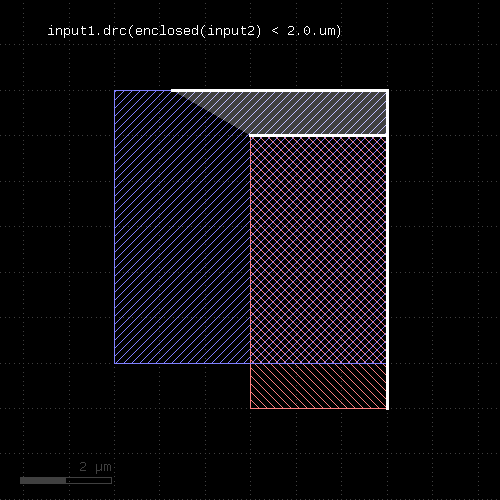
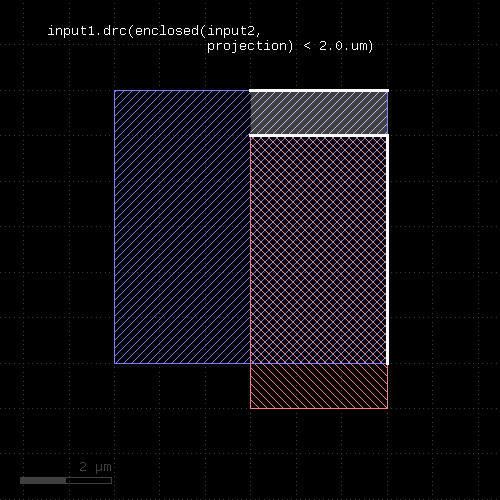
Usage:
"angle" represents the edge orientation filter on the primary shape edges in DRC expressions (see Layer#drc and DRC#angle for more details). In this context, the operation acts similar to Layer#with_angle.
Usage:
See Netter#antenna_check for a description of that function.
Usage:
This function can be used with a layer argument. In this case it is equivalent to "layer.area" (see Layer#area) and returns the total area of the polygons in the layer.
Without a layer argument, "area" represents an area filter for primary shapes in global expressions (see Layer#drc and DRC#area for more details).
Usage:
See Layer#drc, area_ratio and DRC#area_ratio for more details.
Usage:
See Layer#drc, bbox_aspect_ratio and DRC#bbox_aspect_ratio for more details.
Usage:
This method creates a universal DRC expression (see Layer#drc) to select primary shapes whose bounding box height satisfies the condition. Conditions may be written as arithmetic comparisons against numeric values. For example, "bbox_height < 2.0" will select all primary shapes whose bounding box height is less than 2 micrometers. See Layer#drc for more details about comparison specs. Plain "bbox_min" is equivalent to "primary.bbox_min" - i.e. it is used on the primary shape. Also see DRC#bbox_min.
Usage:
See Layer#drc, bbox_max and DRC#bbox_max for more details.
Usage:
See Layer#drc, bbox_min and DRC#bbox_min for more details.
Usage:
See Layer#drc, bbox_height and DRC#bbox_height for more details.
Usage:
Use this class with extract_devices to specify extraction of a bipolar junction transistor
See DeviceExtractorBJT3Transistor for more details about this extractor.
Usage:
Use this class with extract_devices to specify extraction of a bipolar junction transistor with a substrate terminal
See DeviceExtractorBJT4Transistor for more details about this extractor.
Usage:
This function creates a box object. The arguments are the same than for the DBox constructors.
Usage:
Use this class with extract_devices to specify extraction of a capacitor. The area_cap argument is the capacitance in Farad per square micrometer.
See DeviceExtractorCapacitor for more details about this extractor.
Usage:
Use this class with extract_devices to specify extraction of a capacitor with a bulk terminal. The area_cap argument is the capacitance in Farad per square micrometer.
See DeviceExtractorCapacitorWithBulk for more details about this extractor.
Usage:
See Source#cell for a description of that function. In addition to the functionality described there, the global function will also send the output to the specified cell.
The following code will select cell "MACRO" from the input layout:
cell("MACRO")
# shapes now will be taken from cell "MACRO"
l1 = input(1, 0)
Usage:
Hierarchy cheats can be used in deep mode to shortcut hierarchy evaluation for certain cells and consider their local configuration only. Cheats are useful for example when dealing with memory arrays. Often such arrays are build from unit cells and those often overlap with their neighbors. Now, if the hierarchical engine encounters such a situation, it will first analyse all these interactions (which can be expensive) and then it may come to the conclusion that boundary instances need to be handled differently than inside instances. This in turn might lead to propagation of shapes and in an LVS context to device externalisation: because some devices might have different parameters for boundary cells than for inside cells, the device instances can no longer be kept inside the unit cell. Specifically for memory arrays, this is not desired as eventually this leads to flattening of the whole array.
The solution is to cheat: provided the unit cell is fully fledged and neighbors do not disturb the unit cell's configuration in critical ways, the unit cell can be treated as being isolated and results are put together in the usual way.
Cheats can be applied on layout operations - specifically booleans - and device extraction operations. Cheats are only effective in deep mode.
For booleans, a cheat means that the cheating cell's boolean results are computed locally and are combined afterwards. A cheat is introduced this way:
deep
l1 = input(1, 0)
l2 = input(2, 0)
# usual booleans
l1and2 = l1 & l2
# will compute "UNIT_CELL" isolated and everything else in normal hierarchical mode:
l1minus2 = cheat("UNIT_CELL) { l1 - l2 }
The cheat block can also be wrapped in do .. end statements and can return multiple layer objects:
deep
l1 = input(1, 0)
l2 = input(2, 0)
# computes both AND and NOT of l1 and l2 with cheating for "UNIT_CELL"
l1and2, l1minus2 = cheat("UNIT_CELL) do
[ l1 & l2, l1 - l2 ]
end
(Technically, the cheat code block is a Ruby Proc and cannot create variables outside its scope. Hence the results of this code block have to be passed through the "cheat" method).
To apply cheats for device extraction, use the following scheme:
deep
poly = input(1, 0)
active = input(2, 0)
sd = active - poly
gate = active & poly
# device extraction with cheating for "UNIT_CELL":
cheat("UNIT_CELL") do
extract_devices(mos3("NMOS"), { "SD" => sd, "G" => gate, "tS" => sd, "tD" => sd, "tG" => poly }
end
The argument to the cheat method is a list of cell name pattern (glob-style pattern). For example:
cheat("UNIT_CELL*") { ... }
cheat("UNIT_CELL1", "UNIT_CELL2") { ... }
cheat("UNIT_CELL{1,2}") { ... }
For LVS applications, it's usually sufficient to cheat in the device extraction step. Cheats have been introduced in version 0.26.1.
Usage:
See Netter#clear_connections for a description of that function.
Usage:
See Source#clip for a description of that function.
The following code will select shapes within a 500x600 micron rectangle (lower left corner at 0,0) from the input layout. The shapes will be clipped to that rectangle:
clip(0.mm, 0.mm, 0.5.mm, 0.6.mm) # shapes now will be taken from the given rectangle and clipped to it l1 = input(1, 0)
To remove the clip condition, call "clip" without any arguments.
Usage:
See Netter#connect for a description of that function.
Usage:
See Netter#connect_explicit for a description of that function. Net names is an array (use square brackets to list the net names).
Usage:
See Netter#connect_global for a description of that function.
Usage:
See Netter#connect_implicit for a description of that function.
Usage:
This function can be used with a layer argument. In this case it is equivalent to "layer.corners" (see Layer#corners). Without a layer argument, "corners" represents the corner generator/filter in primary shapes for DRC expressions (see Layer#drc and corners for more details).
Like the layer-based version, the "corners" operator accepts the output type option: "as_dots" for dot-like edges, "as_boxes" for small (2x2 DBU) box markers and "as_edge_pairs" for edge pairs. The default output type is "as_boxes".
The "corners" operator can be put into a condition which means it's applied to corners meeting a particular angle constraint.
Usage:
This operator represents the selector of primary shapes which entirely cover shapes from the other layer. This version can be put into a condition indicating how many shapes of the other layer need to be covered. Use this operator within DRC expressions (also see Layer#drc). If can be used as method to an expression. See there for more details: covering.
Usage:
Without any argument, this method gets the database unit used inside the DRC engine.
With an argument, sets the database unit used internally in the DRC engine. Without using that method, the database unit is automatically taken as the database unit of the last input. A specific database unit can be set in order to optimize for two layouts (i.e. take the largest common denominator). When the database unit is set, it must be set at the beginning of the script and before any operation that uses it.
Usage:
In deep mode, the operations will be performed in a hierarchical fashion. Sometimes this reduces the time and memory required for an operation, but this will also add some overhead for the hierarchical analysis.
"deepness" is a property of layers. Layers created with "input" while in deep mode carry hierarchy. Operations involving such layers at the only or the first argument are carried out in hierarchical mode.
Hierarchical mode has some more implications, like "merged_semantics" being implied always. Sometimes cell variants will be created.
Deep mode can be cancelled with tiles or flat.
Usage:
In deep mode, non-orientable (e.g. "8"-shaped) polygons may not be resolved properly. By default the interpretation of such polygons is undefined - they may even vanish entirely. By setting this flag to true, the deep mode layout processor will reject such polygons with an error.
Usage:
The function returns an object describing the current output channel. This channel object can be used like the channels delivered by new_target or new_report.
These readonly attributes are supported by the channel object:
Note, that the channel object will be modified when you use output_cell, target or report calls that change the target.
Usage:
See Netter#device_scaling for a description of that function.
Usage:
Use this class with extract_devices to specify extraction of a planar diode
See DeviceExtractorDiode for more details about this extractor.
Usage:
Use this class with extract_devices to specify extraction of a three-terminal DMOS transistor. A DMOS transistor is essentially the same than a MOS transistor, but source and drain are separated.
See DeviceExtractorMOS3Transistor for more details about this extractor (strict mode applies for 'dmos3').
Usage:
Use this class with extract_devices to specify extraction of a four-terminal DMOS transistor. A DMOS transistor is essentially the same than a MOS transistor, but source and drain are separated.
See DeviceExtractorMOS4Transistor for more details about this extractor (strict mode applies for 'dmos4').
Usage:
This function creates an edge object. The arguments are the same than for the DEdge constructors.
Usage:
The intention of that method is to create an empty layer which can be filled with edge objects using Layer#insert.
Usage:
See Source#edge_pairs for a description of that function.
Usage:
See Source#edges for a description of that function.
Usage:
"enc" is the short form for enclosing.
Usage:
This check verifies if the polygons of the input layer are enclosed by shapes of the other input layer by a certain distance. It has manifold options. See Layer#width for the basic options such as metrics, projection and angle constraints etc. This check also features opposite and rectangle filtering. See Layer#separation for details about opposite and rectangle error filtering.
This function is essentially the reverse of enclosing. In case of "enclosed", the other layer must be bigger than the primary layer.
This function can be used in classic mode with a layer argument. In this case it is equivalent to "layer.enclosed" (see Layer#enclosed).
# classic "enclosed" check for < 0.2 um in = layer(1, 0) other = layer(2, 0) errors = enclosed(in, other, 0.2.um)
The version without a first layer is intended for use within DRC expressions together with the "universal DRC" method Layer#drc. In this case, this function needs to be put into a condition to specify the check constraints. The other options of Layer#enclosed (e.g. metrics, projection constraints, angle limits etc.) apply to this version too:
# universal DRC "enclosed" check for < 0.2 um in = layer(1, 0) other = layer(2, 0) errors = in.drc(enclosed(other) < 0.2.um)
The conditions may involve an upper and lower limit. The following examples illustrate the use of this function with conditions:
out = in.drc(enclosed(other) < 0.2.um) out = in.drc(enclosed(other) <= 0.2.um) out = in.drc(enclosed(other) > 0.2.um) out = in.drc(enclosed(other) >= 0.2.um) out = in.drc(enclosed(other) == 0.2.um) out = in.drc(enclosed(other) != 0.2.um) out = in.drc(0.1.um <= enclosed(other) < 0.2.um)
The result of the enclosed check are edges or edge pairs forming the markers. These markers indicate the presence of the specified condition.
With a lower and upper limit, the results are edges marking the positions on the primary shape where the condition is met. With a lower limit alone, the results are edge pairs which are formed by two identical, but opposite edges attached to the primary shape. Without an upper limit only, the first edge of the marker is attached to the primary shape while the second edge is attached to the shape of the "other" layer.
 |  |
When "larger than" constraints are used, this function will produce the edges from the first layer only. The result will still be edge pairs for consistency, but each edge pair holds one edge from the original polygon plus a reverse copy of that edge in the second member. Use "first_edges" to extract the actual edges from the first input (see separation for an example).
Usage:
This check verifies if the polygons of the input layer are enclosing the shapes of the other input layer by a certain distance. It has manifold options. See Layer#width for the basic options such as metrics, projection and angle constraints etc. This check also features opposite and rectangle filtering. See Layer#separation for details about opposite and rectangle error filtering.
This function can be used in classic mode with a layer argument. In this case it is equivalent to "layer.enclosing" (see Layer#enclosing).
# classic "enclosing" check for < 0.2 um in = layer(1, 0) other = layer(2, 0) errors = enclosing(in, other, 0.2.um)
The version without a first layer is intended for use within DRC expressions together with the "universal DRC" method Layer#drc. In this case, this function needs to be put into a condition to specify the check constraints. The other options of Layer#enclosing (e.g. metrics, projection constraints, angle limits etc.) apply to this version too:
# universal DRC "enclosing" check for < 0.2 um in = layer(1, 0) other = layer(2, 0) errors = in.drc(enclosing(other) < 0.2.um)
The conditions may involve an upper and lower limit. The following examples illustrate the use of this function with conditions:
out = in.drc(enclosing(other) < 0.2.um) out = in.drc(enclosing(other) <= 0.2.um) out = in.drc(enclosing(other) > 0.2.um) out = in.drc(enclosing(other) >= 0.2.um) out = in.drc(enclosing(other) == 0.2.um) out = in.drc(enclosing(other) != 0.2.um) out = in.drc(0.1.um <= enclosing(other) < 0.2.um)
The result of the enclosing check are edges or edge pairs forming the markers. These markers indicate the presence of the specified condition.
With a lower and upper limit, the results are edges marking the positions on the primary shape where the condition is met. With a lower limit alone, the results are edge pairs which are formed by two identical, but opposite edges attached to the primary shape. Without an upper limit only, the first edge of the marker is attached to the primary shape while the second edge is attached to the shape of the "other" layer.
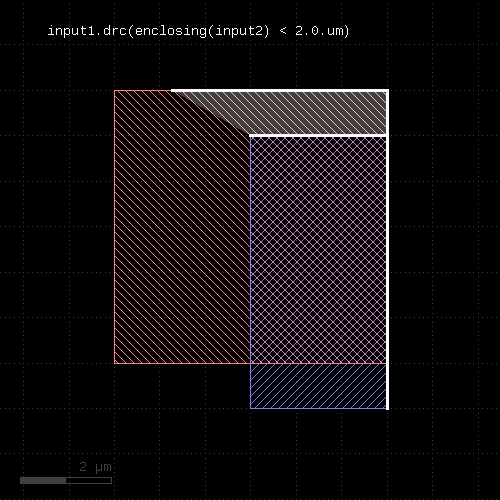 | 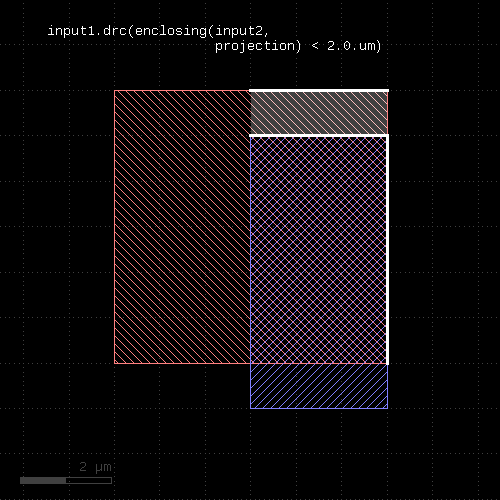 |
When "larger than" constraints are used, this function will produce the edges from the first layer only. The result will still be edge pairs for consistency, but each edge pair holds one edge from the original polygon plus a reverse copy of that edge in the second member. Use "first_edges" to extract the actual edges from the first input (see separation for an example).
Usage:
Similar to log, but the message is printed formatted as an error
Usage:
See Netter#evaluate_nets for a description of that function.
Usage:
See Source#extent for a description of that function.
Usage:
This function can be used with a layer argument. In this case it is equivalent to "layer.extent_refs" (see Layer#extent_refs). Without a layer argument, "extent_refs" represents the partial extents extractor on primary shapes within DRC expressions (see Layer#drc and extent_refs for more details).
Usage:
This function can be used with a layer argument. In this case it is equivalent to "layer.extents" (see Layer#extents). Without a layer argument, "extents" represents the extents generator on primary shapes within DRC expressions (see Layer#drc and extents for more details).
Usage:
See Netter#extract_devices for a description of that function.
Usage:
Disables tiling mode. Tiling mode can be enabled again with tiles later.
Usage:
The primary input of the universal DRC function is the layer the Layer#drc function is called on. This operation represents all "other" primary polygons while primary represents the current polygon.
This feature opens new options for processing layouts beyond the abilities of the classical DRC concept. For classic DRC, intra-layer interactions are always symmetric: a polygon cannot be considered separated from its neighbors on the same layer.
The following example computes every part of the input which is closer than 0.5 micrometers to other (disconnected) polygons on the same layer:
out = in.drc(primary & foreign.sized(0.5.um))
Usage:
Applies a global transformation to the default source layout. See Source#global_transform for a description of this feature.
Usage:
This function can be used with a layer argument. In this case it is equivalent to "layer.holes" (see Layer#hulls). Without a layer argument, "holes" represents a hole extractor for primary shapes in DRC expressions (see Layer#drc and DRC#hulls for more details).
Usage:
This function can be used with a layer argument. In this case it is equivalent to "layer.hulls" (see Layer#hulls). Without a layer argument, "hulls" represents a hull contour extractor for primary shapes in DRC expressions (see Layer#drc and hulls for more details).
Usage:
This function will evaluate the conditions c1 to cn and return the current primary shape if all conditions render a non-empty result. The following example selects all shapes which are rectangles and whose area is larger than 0.5 square micrometers:
out = in.drc(if_all(area > 0.5, rectangles))
The condition expressions may be of any type (edges, edge pairs and polygons).
Usage:
This function will evaluate the conditions c1 to cn and return the current primary shape if at least one condition renders a non-empty result. See if_all for an example how to use the if_... functions.
Usage:
This function will evaluate the conditions c1 to cn and return the current primary shape if all conditions renders an empty result. See if_all for an example how to use the if_... functions.
Usage:
See Netter#ignore_extraction_errors for a description of that function.
Usage:
Prints the message to the log window in verbose mode. In non-verbose more, nothing is printed but a statement is put into the progress window. log is a function that always prints a message.
Usage:
See Source#input for a description of that function. This method will fetch polygons and labels. See polygons and labels for more specific versions of this method.
Usage:
This operator represents the selector of primary shapes which are inside shapes from the other layer. Use this operator within DRC expressions (also see Layer#drc). If can be used as method to an expression. See there for more details: inside.
Usage:
This operator represents the selector of primary shapes which interact with shapes from the other layer. This version can be put into a condition indicating how many shapes of the other layer need to be covered. Use this operator within DRC expressions (also see Layer#drc). If can be used as method to an expression. See there for more details: interacting.
Usage:
Usage:
Usage:
"iso" is the short form for isolated.
Usage:
Provides a intra-polygon space check for polygons. It is similar to space, but checks inter-polygon space only. "iso" is a synonym for "isolated". This check has manifold options. See Layer#width for the basic options such as metrics, projection and angle constraints etc. This check also features opposite and rectangle filtering. See Layer#separation for details about opposite and rectangle error filtering.
This function can be used in classic mode with a layer argument. In this case it is equivalent to "layer.isolated" (see Layer#isolated).
# classic "isolated" check for space < 1.2 um in = layer(1, 0) errors = isolated(in, 1.2.um)
The version without a layer is intended for use within DRC expressions together with the "universal DRC" method Layer#drc. In this case, this function needs to be put into a condition to specify the check constraints. The other options of Layer#isolated (e.g. metrics, projection constraints, angle limits etc.) apply to this version too:
# universal DRC "isolated" check for space < 1.2.um in = layer(1, 0) errors = in.drc(isolated < 1.2.um)
See enclosing for more details about the various ways to specify conditions.
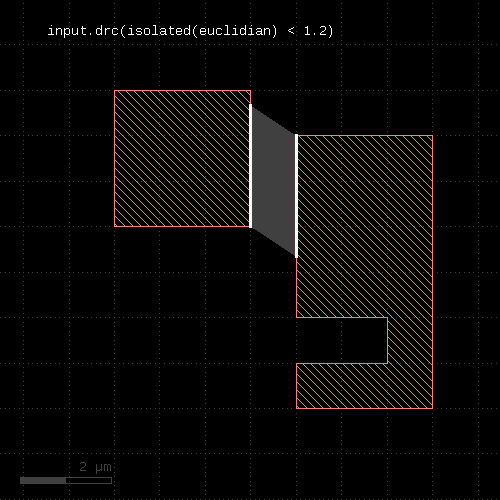 |
Usage:
See Netter#l2n_data for a description of that function.
Usage:
See Source#labels for a description of that function.
Usage:
See Source#layers for a description of that function.
Usage:
This function can be used to specify a new layout for input. It returns an Source object representing that layout. The "input" method of that object can be used to get input layers for that layout.
"what" specifies what input to use. "what" be either
Without any arguments the default layout is returned.
If a file name is given, a cell name can be specified as the second argument. If not, the top cell is taken which must be unique in that case.
Having specified a layout for input enables to use the input method for getting input:
# XOR between layers 1 or the default input and "second_layout.gds":
l2 = layout("second_layout.gds")
(input(1, 0) ^ l2.input(1, 0)).output(100, 0)
For further methods on the source object see Source.
Usage:
This function can be used with a layer argument. In this case it is equivalent to "layer.length" (see Layer#length). Without a layer argument, "length" represents the edge length filter on the primary shape edges in DRC expressions (see Layer#drc and DRC#length for more details). In this context, the operation acts similar to Layer#with_length.
Usage:
Prints the message to the log window. info is a function that prints a message only if verbose mode is enabled.
Usage:
After using that method, the log output is sent to the given file instead of the logger window or the terminal.
Usage:
The intention of this method is to provide an empty polygon layer based on the hierarchical scheme selected. This will create a new layer with the hierarchy of the current layout in deep mode and a flat layer in flat mode. This method is similar to polygon_layer, but the latter does not create a hierarchical layer. Hence the layer created by make_layer is suitable for use in device extraction for example, while the one delivered by polygon_layer is not.
On the other hand, a layer created by the make_layer method is not intended to be filled with Layer#insert.
Usage:
In deep mode, polygons with a bounding box to polygon area ratio bigger than the given number will be split into smaller chunks to optimize performance. Performance gets better if the polygon's bounding boxes do not cover too much of empty space.
The area ratio is a signed value. Negative values indicate to use the outer manhattan approximation of the polygons for the area ratio. Positive values indicate to take the polygons as they are. The sign of the value indicates the mode - the actual area ratio checked is the absolute value.
For manhattan polygons, an area ratio of -3.0 gives the same results than a positive 3.0. For non-manhattan polygons and a negative area ratio, the area taken for the polygon is larger than the actual polygon area. So splitting is less likely in this case. This avoids degeneration of the polygon assembly, which can otherwise happen for skinny diagonal polygons. These are usually resolved into a large number of small triangles with no benefit for the algorithms.
With a negative area ratio, triangles are equivalent to their bounding box and always have an area ratio of 1.0.
The default value is -3.0 which gives fairly compact polygons and is using their outer manhattan approximation. Skinny diagonals will be maintained.
Use this method with a numeric argument to set the value and without an argument to get the current maximum area ratio. Set the value to zero to disable splitting by area ratio.
See also max_vertex_count for the other option affecting polygon splitting.
Usage:
In deep mode, polygons with more than the given number of vertexes will be split into smaller chunks to optimize performance (which is better or less complex polygons). The default threshold is 16 vertexes. Use this method with a vertex count to set the value and without an argument to get the current maximum vertex count. Set the value to zero to disable splitting by vertex count.
See also max_area_ratio for the other option affecting polygon splitting.
Usage:
This function can be used with a layer argument. In this case it is equivalent to "layer.middle" (see Layer#middle). Without a layer argument, "middle" represents the bounding box center marker generator on primary shapes within DRC expressions (see Layer#drc and middle for more details).
Usage:
Use this class with extract_devices to specify extraction of a three-terminal MOS transistor.
See DeviceExtractorMOS3Transistor for more details about this extractor (non-strict mode applies for 'mos3').
Usage:
Use this class with extract_devices to specify extraction of a four-terminal MOS transistor.
See DeviceExtractorMOS4Transistor for more details about this extractor (non-strict mode applies for 'mos4').
Usage:
See Netter#name for a description of that function.
Usage:
See Netter#name_prefix for a description of that function.
The netlist is a Netlist object. If no netlist is extracted yet, this method will trigger the extraction process. See Netter#netlist for a description of this function.
Usage:
See Netter for more details
Usage:
This method creates an independent report object. This object can be used in "output" to send a layer to a different report than the default report or target.
Arguments are the same than for report.
See Layer#output for details about this feature.
Usage:
This method creates an independent target object. This object can be used in "output" to send a layer to a different layout file than the default report or target.
Arguments are the same than for target.
See Layer#output for details about this feature.
Usage:
Resets the tile borders - see tile_borders for a description of tile borders.
Usage:
Provides a intra-polygon space check for polygons. It is similar to space, but checks intra-polygon space only. It has manifold options. See Layer#width for the basic options such as metrics, projection and angle constraints etc.
This function can be used in classic mode with a layer argument. In this case it is equivalent to "layer.notch" (see Layer#notch).
# classic "notch" check for space < 1.2 um in = layer(1, 0) errors = notch(in, 1.2.um)
The version without a layer is intended for use within DRC expressions together with the "universal DRC" method Layer#drc. In this case, this function needs to be put into a condition to specify the check constraints. The other options of Layer#notch (e.g. metrics, projection constraints, angle limits etc.) apply to this version too:
# universal DRC "notch" check for space < 1.2.um in = layer(1, 0) errors = in.drc(notch < 1.2.um)
See enclosing for more details about the various ways to specify conditions.
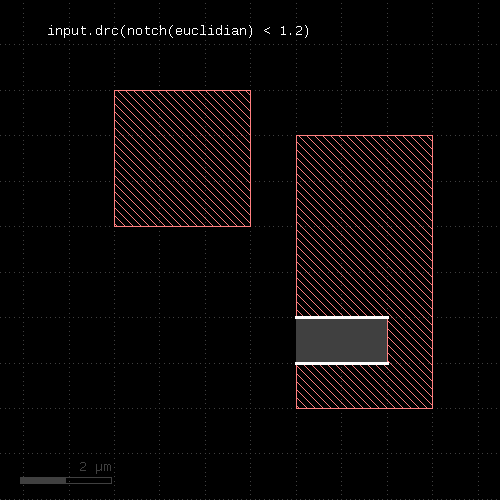 |
Usage:
This function is equivalent to "layer.output(args)". See Layer#output for details about this function.
Usage:
This method switches output to the specified cell, but does not change the target layout nor does it switch the output channel to layout if is report database.
Usage:
This operator represents the selector of primary shapes which are outside shapes from the other layer. Use this operator within DRC expressions (also see Layer#drc). If can be used as method to an expression. See there for more details: outside.
Usage:
Provides an overlap check (primary layer vs. another layer). This check has manifold options. See Layer#width for the basic options such as metrics, projection and angle constraints etc. This check also features opposite and rectangle filtering. See Layer#separation for details about opposite and rectangle error filtering.
Like other checks, this function is available as a classic DRC function with a layer as the first argument and as an DRC expression operator for use with Layer#drc.
# classic "overlap" check for < 0.2 um in = layer(1, 0) other = layer(2, 0) errors = overlap(in, other, 0.2.um)
For use with the "unversal DRC" put the separation expression into the "drc" function call and use a condition to specify the constraint:
# universal DRC "overlap" check for < 0.2 um in = layer(1, 0) other = layer(2, 0) errors = in.drc(overlap(other) < 0.2.um)
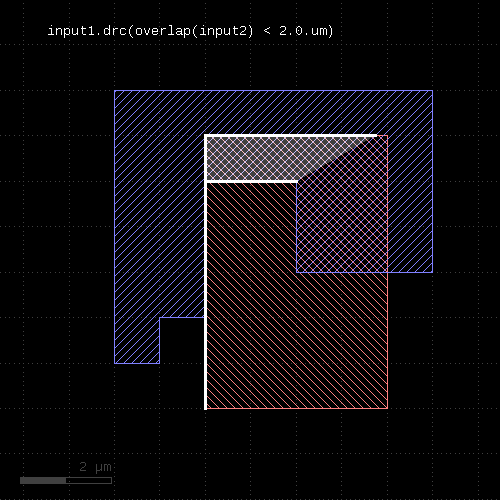 |  |
When "larger than" constraints are used, this function will produce the edges from the first layer only. The result will still be edge pairs for consistency, but each edge pair holds one edge from the original polygon plus a reverse copy of that edge in the second member. Use "first_edges" to extract the actual edges from the first input (see separation for an example).
Usage:
This operator represents the selector of primary shapes which overlap shapes from the other layer. This version can be put into a condition indicating how many shapes of the other layer need to be covered. Use this operator within DRC expressions (also see Layer#drc). If can be used as method to an expression. See there for more details: overlapping.
Usage:
A point is not a valid object by itself, but it is useful for creating paths for polygons:
x = polygon_layer x.insert(polygon([ p(0, 0), p(16.0, 0), p(8.0, 8.0) ]))
Usage:
This function creates a path object. The arguments are the same than for the DPath constructors.
Usage:
This function can be used with a layer argument. In this case it is equivalent to "layer.perimeter" (see Layer#perimeter) and returns the total perimeter of all polygons in the layer.
Without a layer argument, "perimeter" represents a perimeter filter for primary shapes in DRC expressions (see Layer#drc and DRC#perimeter for more details).
Usage:
This function creates a polygon object. The arguments are the same than for the DPolygon constructors.
Usage:
The intention of that method is to create an empty layer which can be filled with polygon-like objects using Layer#insert. A similar method which creates a hierarchical layer in deep mode is make_layer. This other layer is better suited for use with device extraction.
Usage:
See Source#polygons for a description of that function.
Usage:
The primary input of the universal DRC function is the layer the Layer#drc function is called on.
Usage:
Turns profiling on or off (default). In profiling mode, the system will collect statistics about rules executed, their execution time and memory information. The argument specifies how many operations to print at the end of the run. Without an argument, all operations are printed. Passing "false" for the argument will disable profiling. This is the default.
This properties constraint does not constrain the operation, but instructs it to attach the properties from the primary input to the output objects.
See also props_ne and props_eq.
Some operations such as boolean AND support properties constraints. By giving a "props_eq" constraint, the operation is performed only on shapes with the same properties, where "properties" stands for the full set of key/value pairs.
Note that you have to enable properties explicitly or generate properties (e.g. with the DRCLayer#nets method).
Example:
connect(metal1, via1) connect(via1, metal2) ... further connect statements m1m2_overlap_connected = metal1.nets.and(metal2, props_eq)
"props_eq" can be combined with props_copy. In this case, properties are transferred to the output shapes and can be used in further processing:
m1m2_overlap_connected = metal1.nets.and(metal2, props_eq + props_copy)
See also props_ne.
Some operations such as boolean AND support properties constraints. By giving a "props_ne" constraint, the operation is performed only on shapes with different properties, where "properties" stands for the full set of key/value pairs.
Note that you have to enable properties explicitly or generate properties (e.g. with the DRCLayer#nets method).
Example:
connect(metal1, via1) connect(via1, metal2) ... further connect statements m1m2_overlap_not_connected = metal1.nets.and(metal2, props_ne)
"props_ne" can be combined with props_copy. In this case, properties are transferred to the output shapes and can be used in further processing:
m1m2_overlap_connected = metal1.nets.and(metal2, props_ne + props_copy)
See also props_eq.
Usage:
This function can be used with a layer argument. In this case it is equivalent to "layer.rectangles" (see Layer#rectangles). Without a layer argument, "rectangles" represents the rectangles filter for primary shapes in DRC expressions (see Layer#drc and rectangles for more details).
Usage:
This function can be used with a layer argument. In this case it is equivalent to "layer.rectilinear" (see Layer#rectilinear). Without a layer argument, "rectilinear" represents the rectilinear polygons filter for primary shapes in DRC expressions (see Layer#drc and rectilinear for more details).
Usage:
See Source#overlapping for a description of that function.
The following code will select shapes overlapping a 500x600 micron rectangle (lower left corner at 0,0) from the input layout. The shapes will not be clipped:
region_overlapping(0.mm, 0.mm, 0.5.mm, 0.6.mm) # shapes will now be the ones overlapping the rectangular region l1 = input(1, 0)
To remove this condition, call "region_overlapping" without any arguments.
Usage:
See Source#touching for a description of that function.
The following code will select shapes touching a 500x600 micron rectangle (lower left corner at 0,0) from the input layout. The shapes will not be clipped:
region_touch(0.mm, 0.mm, 0.5.mm, 0.6.mm) # shapes will now be the ones touching the rectangular region l1 = input(1, 0)
To remove this condition, call "region_touch" without any arguments.
Usage:
See Layer#drc, relative_height and DRC#relative_height for more details.
Usage:
After specifying a report database for output, output method calls are redirected to the report database. The format of the output calls changes and a category name plus description can be specified rather than a layer/datatype number of layer name. See the description of the output method for details.
If a filename is given, the report database will be written to the specified file name. Otherwise it will be shown but not written.
If external input is specified with source, "report" must be called after "source".
The cellname specifies the top cell used for the report file. By default this is the cell name of the default source. If there is no source layout you'll need to give the cell name in the third parameter.
The return value of this method is a channel object of the same type that new_report will return.
Usage:
This method applies to runsets creating a netlist through extraction. Extraction happens when connections and/or device extractions are made. If this statement is used, the extracted netlist plus the net and device shapes are turned into a layout-to-netlist report (L2N database) and shown in the netlist browser window. If a file name is given, the report will also be written to the given file. If a file name is given and "long" is true, a verbose version of the L2N DB format will be used.
Usage:
Use this class with extract_devices to specify extraction of a resistor.
The sheet_rho value is the sheet resistance in ohms/square. It is used to compute the resistance from the geometry.
See DeviceExtractorResistor for more details about this extractor.
Usage:
Use this class with extract_devices to specify extraction of a resistor with a bulk terminal. The sheet_rho value is the sheet resistance in ohms/square.
See DeviceExtractorResistorWithBulk for more details about this extractor.
Usage:
This function can be used with a layer argument. In this case it is equivalent to "layer.rounded_corners" (see Layer#rounded_corners). Without a layer argument, "rounded_corners" represents the corner rounding algorithm on primary shapes within DRC expressions (see Layer#drc and rounded_corners for more details).
Usage:
To supply additional input for the universal DRC expressions (see Layer#drc), use "secondary" with a layer argument. This example provides a boolean AND between l1 and l2:
l1 = layer(1, 0) l2 = layer(2, 0) out = l1.drc(primary & secondary(l2))
Usage:
See Source#select for a description of that function. Using the global version does not create a new source, but modifies the default source.
# Selects only B cell instances below the top cell
select("-", "+B*")
l1 = input(1, 0)
Usage:
"sep" is the short form for separation.
Usage:
Provides a separation check (primary layer vs. another layer). Like enclosing this function provides a two-layer check, but checking the distance rather than the overlap. This check has manifold options. See Layer#width for the basic options such as metrics, projection and angle constraints etc. This check also features opposite and rectangle filtering. See Layer#separation for details about opposite and rectangle error filtering.
Like enclosing, this function is available as a classic DRC function with a layer as the first argument and as an DRC expression operator for use with Layer#drc.
# classic "separation" check for distance < 0.2 um in = layer(1, 0) other = layer(2, 0) errors = separation(in, other, 0.2.um)
For use with the "universal DRC" put the separation expression into the "drc" function call and use a condition to specify the constraint:
# universal DRC "separation" check for distance < 0.2 um in = layer(1, 0) other = layer(2, 0) errors = in.drc(separation(other) < 0.2.um)
enclosing explains the constraints and how the work in generating error markers.
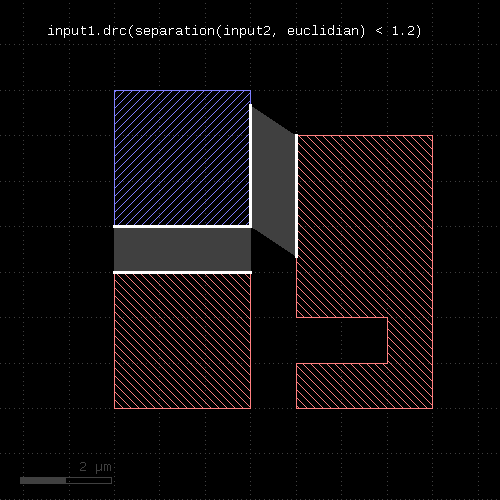 |
When "larger than" constraints are used, this function will produce the edges from the first layer only. The result will still be edge pairs for consistency, but each edge pair holds one edge from the original polygon plus a reverse copy of that edge in the second member. Use "first_edges" to extract the actual edges from the first input:
l1_edges_without_l2 = l1.drc((separation(l2) >= 1.0).first_edges)
The following image shows the effect of such a negative-output separation check:
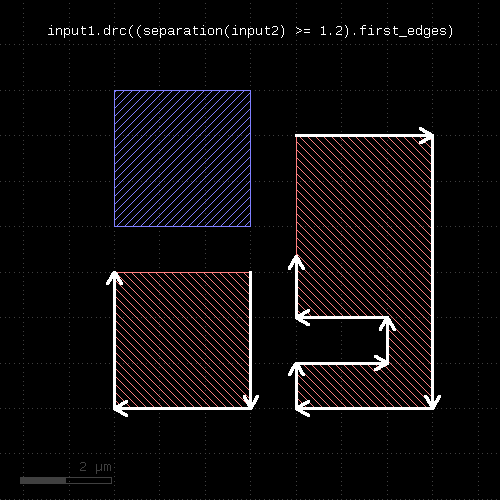 |
Usage:
This function is equivalent to "verbose(false)" (see verbose)
Usage:
This function can be used with a layer argument. In this case it is equivalent to "layer.sized" (see Layer#sized). Without a layer argument, "sized" represents the polygon sizer on primary shapes within DRC expressions (see Layer#drc and sized for more details).
Usage:
This function can be used with a layer argument. In this case it is equivalent to "layer.smoothed" (see Layer#smoothed). Without a layer argument, "smoothed" represents the polygon smoother on primary shapes within DRC expressions (see Layer#drc and smoothed for more details).
Usage:
A "soft connection" is made between two layers and is a directional connection (like an ideal diode). Soft connections allow detecting if nets are connected via a high-ohmic substrate or diffusion layer (the "lower" layer). "b" is the "lower" and "a" the upper layer.
See Netter#connect for a more detailed description of that function.
Usage:
Like soft_connect, a soft connection is made between a layer and a global net (e.g. substrate). The global net is always the "lower" net of the soft connection.
See Netter#soft_connect_global for a more detailed description of that function.
Usage:
This function replaces the default source layout by the specified file. If this function is not used, the currently active layout is used as input.
layout is a similar method which specifies an additional input layout.
"what" specifies what input to use. "what" be either
Without any arguments the default layout is returned. If a filename is given, a cell name can be specified as the second argument. If none is specified, the top cell is taken which must be unique in that case.
# XOR between layers 1 of "first_layout.gds" and "second_layout.gds" and sends the results to "xor_layout.gds":
target("xor_layout.gds")
source("first_layout.gds")
l2 = layout("second_layout.gds")
(input(1, 0) ^ l2.input(1, 0)).output(100, 0)
For further methods on the source object see Source.
Usage:
"space" looks for spacing violations between edges of the same polygon (intra-polygon checks) and between different polygons (inter-polygon checks). notch is similar function that provides only intra-polygon space checks. isolated is the version checking inter-polygon distance only. The check has manifold options. See Layer#width for the basic options such as metrics, projection and angle constraints etc.
This function can be used in classic mode with a layer argument. In this case it is equivalent to "layer.space" (see Layer#space). In this mode, "space" is applicable to edge layers too.
# classic "space" check for space < 0.2 um in = layer(1, 0) errors = space(in, 0.2.um)
The version without a layer is intended for use within DRC expressions together with the "universal DRC" method Layer#drc. In this case, this function needs to be put into a condition to specify the check constraints. The other options of Layer#space (e.g. metrics, projection constraints, angle limits etc.) apply to this version too:
# universal DRC check for space < 0.2.um in = layer(1, 0) errors = in.drc(space < 0.2.um)
See enclosing for more details about the various ways to specify conditions.
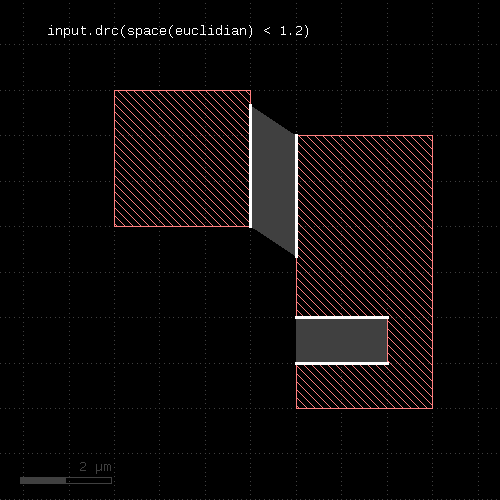 |
Usage:
This function can be used with a layer argument. In this case it is equivalent to "layer.squares" (see Layer#squares). Without a layer argument, "squares" represents the rectangles filter for primary shapes in DRC expressions (see Layer#drc and squares for more details).
Usage:
This function provides a conditional selector for the "drc" function. It is used this way:
out = in.drc(switch(c1, r1, c2, r2, ..., cn, rn) out = in.drc(switch(c1, r1, c2, r2, ..., cn, rn, rdef)
This function will evaluate c1 which is a universal DRC expression (see Layer#drc). If the result is not empty, "switch" will evaluate and return r1. Otherwise it will continue with c2 and the result of this expression is not empty it will return r2. Otherwise it will continue with c3/r3 etc.
If an odd number of arguments is given, the last expression is evaluated if none of the conditions c1..cn gives a non-empty result.
As a requirement, the result types of all r1..rn expressions and the rdef needs to be the same - i.e. all need to render polygons or edges or edge pairs.
Usage:
This function can be used to specify a target layout for output. Subsequent calls of "output" will send their results to that target layout. Using "target" will disable output to a report database. If any target was specified before, that target will be closed and a new target will be set up.
"what" specifies what input to use. "what" be either
Except if the argument is a Cell object, a cellname can be specified stating the cell name under which the results are saved. If no cellname is specified, either the current cell or "TOP" is used.
The return value of this method is a channel object of the same type that new_target will return.
Usage:
This method applies to runsets creating a netlist through extraction. Extraction happens when connections and/or device extractions are made. If this statement is used, the extracted netlist is written to the given file.
The format parameter specifies the writer to use. You can use nil to use the standard format or produce a SPICE writer with write_spice. See write_spice for more details.
Usage:
If using threads, tiles are distributed on multiple CPU cores for parallelization. Still, all tiles must be processed before the operation proceeds with the next statement.
Without an argument, "threads" will return the current number of threads
Usage:
The tile border specifies the distance to which shapes are collected into the tile. In order words, when processing a tile, shapes within the border distance participate in the operations.
For some operations such as booleans (Layer#and, Layer#or, ...), Layer#size and the DRC functions (Layer#width, Layer#space, ...) a tile border is automatically established. For other operations such as Layer#with_area or Layer#edges, the exact distance is unknown, because such operations may have a long range. In that cases, no border is used. The tile_borders function may be used to specify a minimum border which is used in that case. That allows taking into account at least shapes within the given range, although not necessarily all.
To reset the tile borders, use no_borders or "tile_borders(nil)".
Usage:
Specifies tiling mode. In tiling mode, the DRC operations are evaluated in tiles with width w and height h. With one argument, square tiles with width and height t are used.
Special care must be taken when using tiling mode, since some operations may not behave as expected at the borders of the tile. Tiles can be made overlapping by specifying a tile border dimension with tile_borders. Some operations like sizing, the DRC functions specify a tile border implicitly. Other operations without a defined range won't do so and the consequences of tiling mode can be difficult to predict.
In tiling mode, the memory requirements are usually smaller (depending on the choice of the tile size) and multi-CPU support is enabled (see threads). To disable tiling mode use flat or deep.
Tiling mode will disable deep mode (see deep).
Usage:
See Netter#top_level for a description of that function.
Usage:
In verbose mode, more output is generated in the log file
Usage:
In verbose mode, more output is generated in the log file
Usage:
Similar to log, but the message is printed formatted as a warning
Usage:
A width check is a check for the distance of edges of the same polygon.
This function can be used in classic mode with a layer argument. In this case it is equivalent to "layer.width" (see Layer#width).
# classic "width" check for width < 2 um in = layer(1, 0) errors = width(in, 0.2.um)
The version without a layer is intended for use within DRC expressions together with the "universal DRC" method Layer#drc. In this case, this function needs to be put into a condition to specify the check constraints. The other options of Layer#width (e.g. metrics, projection constraints, angle limits etc.) apply to this version too:
# universal DRC check for width < 2 um in = layer(1, 0) errors = in.drc(width < 0.2.um)
The conditions may involve an upper and lower limit. The following examples illustrate the use of this function with conditions:
errors = in.drc(width < 0.2.um) errors = in.drc(width <= 0.2.um) errors = in.drc(width > 0.2.um) errors = in.drc(width >= 0.2.um) errors = in.drc(width == 0.2.um) errors = in.drc(width != 0.2.um) errors = in.drc(0.1.um <= width < 0.2.um)
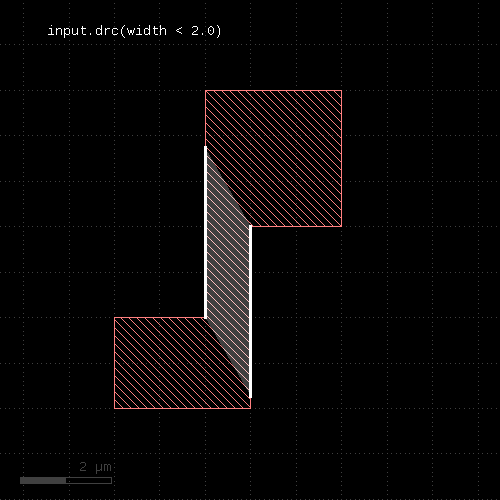 |  |
With a lower and upper limit or with the "equal" condition, the results are edges marking the positions on the primary shape where the condition is met. With a lower limit alone, the results are edge pairs which are formed by two identical, but opposite edges attached to the primary shape. Without an upper limit only, both edges are attached to different sides of the primary shape.
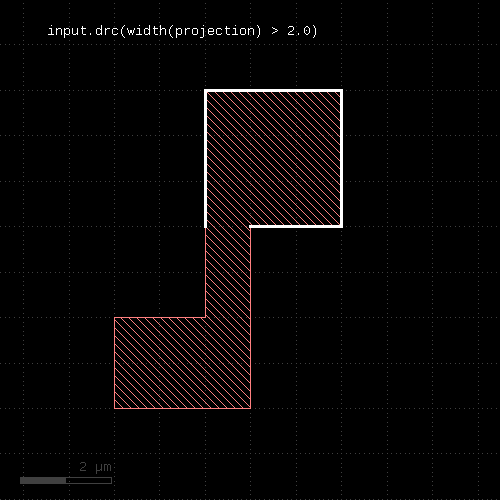 | 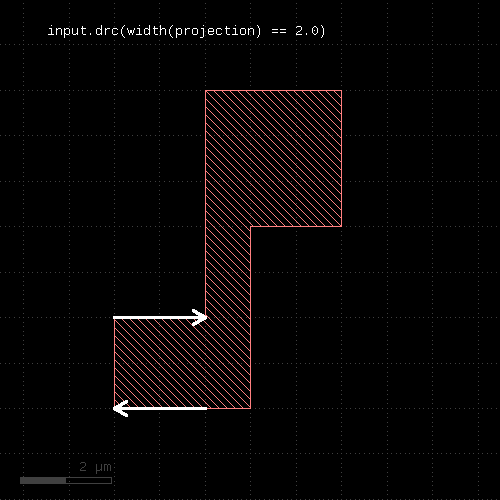 |
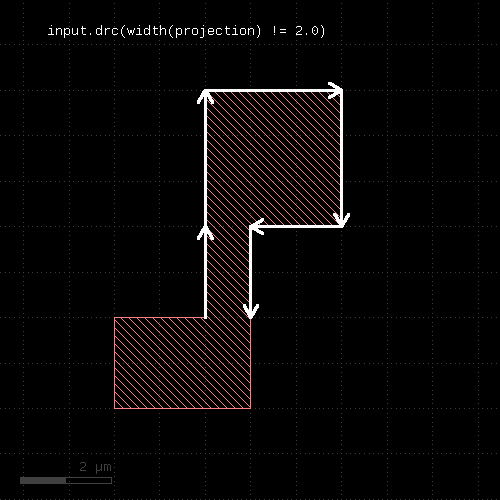 |  |
Usage:
"with_holes" represents a polygon selector for DRC expressions selecting polygons of the primary by their number of holes (see Layer#drc and with_holes for more details).
Usage:
Use this option in target_netlist for the format parameter to specify SPICE format. "use_net_names" and "with_comments" are boolean parameters indicating whether to use named nets (numbers if false) and whether to add information comments such as instance coordinates or pin names.
"writer_delegate" allows using a NetlistSpiceWriterDelegate object to control the actual writing.